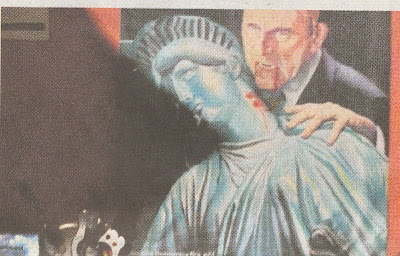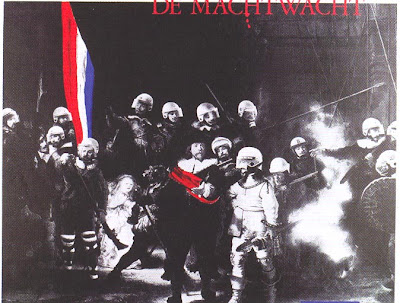 star
starquoted American presidential
speechwriter David Frum explaining how the term axis of evil came about. Frum was called in by the chief speechwriter and asked: "Can you sum up in a sentence or two our best case for going after Iraq?" Frum said later: "I was to provide a justification for a war."
He first called Iraq part of an "axis of hatred" and, later, this became "axis of evil". As Time magazine says, this became the defining phrase of a presidency. It has been the phrase used by US President George W Bush to justify the invasion of Iraq.
नेक्स्ट by Anthony ब्रोवं विया
tpaIt wasn’t the television studios, or the boss’s office the size of an Olympic swimming pool. It wasn’t the auditorium for 200 people, or the ten-storey-high purpose-built building with a two-storey atrium. It wasn’t the overseas offices in Oman and Beijing, the staff of 400, the oak-panelled corridors, or the oil paintings lining the walls numerous enough to set up an art gallery. It wasn’t the $300 million endowment, or the ability to raise $2.3 million from a single fundraising dinner (with tables going for $75,000 a time). It wasn’t the fact that my meeting with one institute’s president was delayed because a real president — of Panama — had dropped by, squeezed in between a former president of Indonesia and the supreme allied commander of NATO.
No, what really brought home to me the gaping difference between American and British think tanks last week was bumping into David Frum, George Bush’s former speechwriter, in the lift of the
American Enterprise Institute, in whose waitress-service canteen I had just dined sitting next to Paul Wolfowitz, the former head of the World Bank. Other think-tank colleagues there include John Bolton, the US ambassador to the United Nations, and
Ayaan Hirsi Ali, the enormously courageous Somali-born apostate and former Dutch politician. In Britain, top policy thinkers choose to work in universities; in the US they choose to work in think tanks. ‘Think tanks are more important than universities now,’ Frum told me, without a hint of immodesty. Even though I lead Policy Exchange, Britain’s (and arguably Europe’s) largest centre-right think tank, I wouldn’t dare to claim we are more important than a university.
In a whirlwind tour of US think tanks last week, I tried to find the reasons — beyond the US’s obvious size and wealth — for the differences between their think tanks and ours. American think tanks, such as the Brookings Institute, the Heritage Foundation, the Hudson Institute or Cato, are major institutions that bestride the political and media scene whether the political weather is favourable or not. And those are just a few of the Washington ones — there are dozens more where they come from, plus a plethora of smaller think tanks in pretty much all the state capitals. An annual two-day convention for think-tank leaders (last held in Atlanta a few weeks ago) attracts over 700 people. The plush personal offices of US think-tank presidents ooze power and prestige as much as the offices of leading politicians.
British think tanks, by contrast, generally eke out a subsistence existence in pokey offices, living hand to mouth, never quite sure not just what the future holds, but where the next pound is coming from. Rather than being permanent institutions, they are generally very ephemeral, prisoners of political fashion, enjoying 15 minutes of fame before sliding into irrelevance and obscurity, kept going by the warming memories of glories past. On the right, the Institute of Economic Affairs, the Centre for Policy Studies and the Adam Smith Institute, which did such a remarkable job saving Britain from its 1970s self, have all seen busier times. The Blairite Institute for Public Policy Research is beset by rumours of its decline now that its patron is no longer in Number 10; the once über-hip Cool Britannia-creating Demos just announced that it won’t be doing any events at the party conferences this autumn because it is too costly. Only our venerable empire-era foreign policy think tanks — the Royal Institute for International Affairs, the Royal United Services Institute and the International Institute for Strategic Studies — have broken out of the cycle, ploughing a relatively lucrative furrow advising governments.
America has a more advanced culture of philanthropy than the UK (like the main think tanks in the UK, those in Washington are generally charities relying on personal donations). But in the US there is a breed of ‘policy philanthropists’ who give vast amounts of money to promote ideas, believing that changing the nation’s ideas and policies has a bigger impact than funding a community project. Indeed, the creedal nation, united by a belief in freedom rather than by ethnicity, seems to have a great belief in the power of ideas to shape the future, reflected in their astonishingly vigorous factual literature.
It isn’t just major American donors who believe in ideas. The Heritage Foundation (patron: Baroness Thatcher), the largest conservative think tank, has a staggering 335,000 individual donors, many of which give under a $100 a year, and has a target of 1 million — one in 300 Americans. It attracts support by campaigning vigorously for conservative values and policies, as well as coming up with new conservative ideas. The American political system, with its greater checks and balances, is also more open to lobbying — for ideas or special interests — than Britain’s elective dictatorship.
Like much of the US non-profit sector, the Washington think tanks are extremely professional compared to their British cousins. They can afford to buy in the best in the business, having teams of professional fundraisers running astonishingly slick direct-mail campaigns and putting on gala dinners across that continental nation, eliciting support through an irresistible barrage of newsletters, pamphlets and advertisements.
Their more professional business models have given US think tanks extraordinary financial security. The Heritage has an income of $60 million, nearly 20 times as much as the largest centre-right British one (Policy Exchange). All the main US think tanks have major endowments (the AEI has $60 million, the Brookings $300 million), meaning they can more effectively plan ahead. The libertarian Cato Institute has already built its own building, while the AEI (‘a university without students’) is planning to do so.
The big question, of course, is whether any of this matters. It does if you believe that policy making is too important to be left to government-paid policy makers. And also if you are right of centre. Political parties, engaged in hand-to-hand combat with their opponents, and necessarily obsessed with day-to-day headlines, are generally incapable of long-term serious thought. Universities are pretty much monopolised by the Left, and seem to rejoice in their lack of real-world impact. A whole raft of lobby groups from Liberty to Refugee Action to the Child Poverty Action Group get endless free BBC airtime promoting pretty uniformly left-wing viewpoints.
A new generation of centre-right think tanks, such as Policy Exchange, the TaxPayers’ Alliance and the Centre for Social Justice, are currently thriving with the political momentum in our direction. But to stay relevant and vibrant, conservative thinking needs to be sustained throughout the political cycle: the case for conservatism needs to be made strongest when conservatism is least fashionable.
In the US, the flourishing centre-right think tanks have helped push the whole political centre of gravity way to the right of that of the UK. The AEI is (in)famous for promoting the invasion of Iraq, while Heritage has kept social conservatism and the importance of religion high on the policy agenda. Cato has helped mute the siren calls of protectionism.
Those on the right of centre in Britain often complain that the Left has been far better at promoting its ideas, while commentators often complain about the shallow state of debate in Britain. But with such a weakened ideas industry, it’s no surprise that our ideas aren’t thriving. It would be far healthier for democracy and debate in Britain if our ideas industry managed to step up to the American level.
Anthony Browne Is Director Of Policy Exchange.
 Kinderboek
Kinderboek